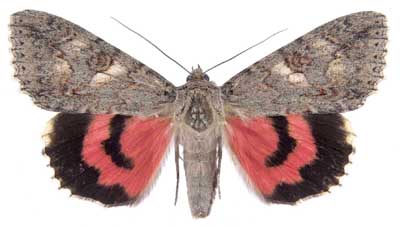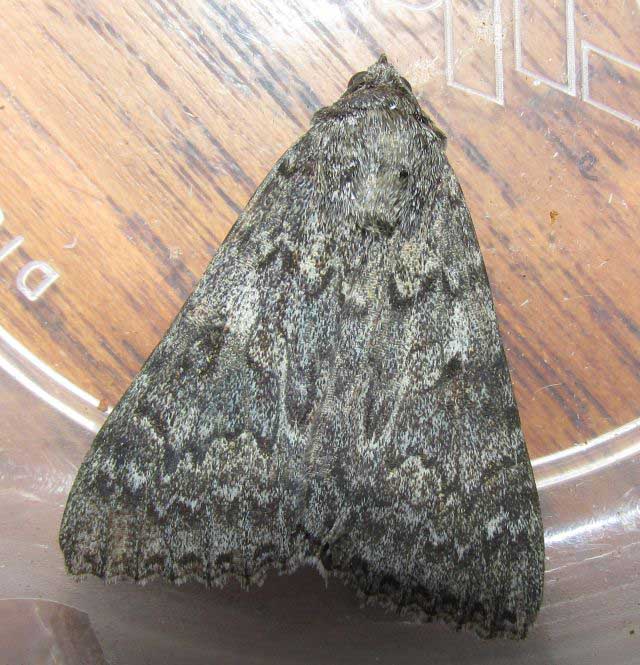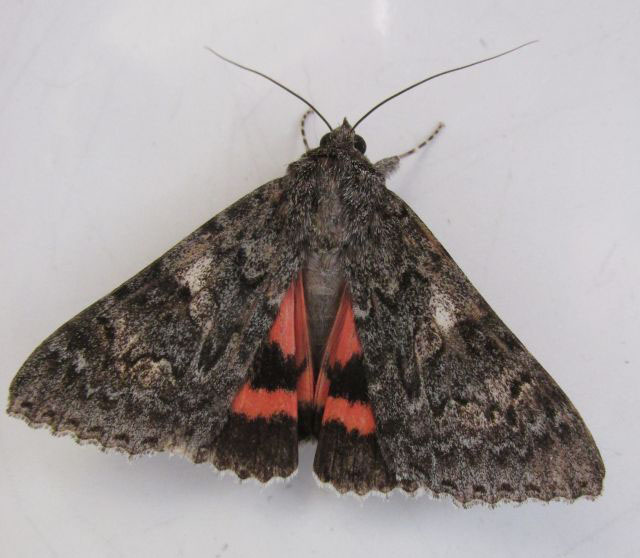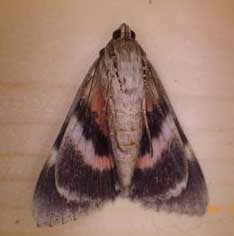Catocala faustina cleopatra
kah-TOCK-uh-lahMfows-TEE-nuhMklee-OH-pa-truh
Strecker, 1874

Catocala faustina cleopatra, British Columbia.

Catocala faustina cleopatra, Wolf Creek, Josephine County, Oregon,
September 11, 2013, courtesy of Edna Woodward, tentative id by Bill Oehlke
This site has been created by
Bill Oehlke at oehlkew@islandtelecom.com
Comments, suggestions and/or additional information are welcomed by Bill.
| TAXONOMY:
Superfamily: Noctuoidea
Family: Noctuidae
Group: Noctuinina
Subfamily: Catocalinae
Genus: Catocala, Schrank, 1802
| |
MIDI MUSIC
"Moon River"
copyright C. Odenkirk
MIDI CITYON.OFF
<bgsound src="moon.mid" LOOP=FOREVER>
|
DISTRIBUTION:
Catocala faustina cleopatra,
(wingspan: 65mm) flies from
British Columbia south to
California. It should also be in Washington and
Oregon.
Specimens from the coastal areas of northern California, Oregon, Washington and British Columbia are classified as C. faustina allusa.
C. faustina allusa blends with C. faustina cleopatra in northwestern California, and with C. faustina faustina in the Rocky Mountains of
Idaho, Wyoming and Montana.

Catocala faustina cleopatra, Wolf Creek, Josephine County, Oregon,
September 11, 2013, courtesy of Edna Woodward, tentative id by Bill Oehlke
C. cleopatra is now (2010) regarded as a subspecies of faustina.
The head and thorax are a dark bluish grey while the abdomen is a brownish grey. The primaries are dark bluish grey. The transverse lines, reniform and
sub-reniform are indistinct with some yellowish brown shading on the upper surface.
The bands are relatively narrow, the fringe (unbroken) is white on the exterior margin and grey near the abdomen.

Catocala faustina cleopatra, male, Bakersfield, Kern County, CA,
400', Kelly Richers collector, on fence, June 22 1983.

| FLIGHT TIMES AND PREFERRED FOOD PLANTS: Catocala faustina cleopatra are usually on the wing from June to early September
(September 12, 2013 image left, Wolf Creek, Oregon).
The Catocala cleopatra caterpillar feeds on Gleditsia triacanthos, Malus, Malus pumila, Prunus, Prunus americana, Prunus ilicifolia and Ulmus.
|
ECLOSION:
Adults eclose from pupae at soil surface.
SCENTING AND MATING:
Catocala faustina cleopatra females emit an airbourne pheromone and males use their antennae to track the scent plume.
EGGS, CATERPILLARS, COCOONS AND PUPAE:
Eggs are deposited on tree bark in the fall and hatch the following spring.
Larval Food Plants
Listed below are primary food plant(s) and alternate food plants. It is hoped that this alphabetical listing followed by the common
name of the foodplant will prove useful. The list is not exhaustive, although some species seem very host specific.
Experimenting with closely related foodplants is worthwhile.
Gleditsia triacanthos
Malus
Malus pumila
Prunus
Prunus americana
Prunus ilicifolia
Ulmus
|
|
Return to Main Index
This page is brought to you by Bill Oehlke and the
WLSS. Pages are on space rented from Bizland. If you would like to become a "Patron of the Sphingidae/Catocala Sites",
contact Bill.
Please send sightings/images to Bill. I will do my best to respond to requests for identification help.
Enjoy one of nature's wonderments: Live Saturniidae (Giant Silkmoth) cocoons.

|

To show appreciation for this site, click on the flashing
butterfly to the left, a link
to many worldwide insect sites. |






